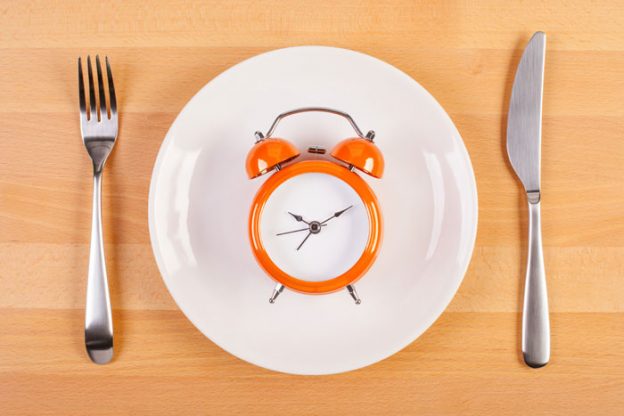By Anthoney J. Andersen – Steroidal.com
In a world where losing weight and building muscle can be quite daunting – due to the plethora of diet plans, workout regimens and performance supplements – achieving the body that you desire can sometimes seem next to impossible.
So, as summer approaches, many people will be flocking to the gym to obtain those washboard abs, toned arms, legs, and glutes. But to accomplish your fitness goals at a more accelerated rate, you must couple your strength training regimen with a strict diet plan.

But which diet plan is the best for you?
As hard as it is to stave off certain foods – as well as count your daily caloric and fat intake – what if you were told that not eating at all for short periods of time would help you drop the weight even faster?
Think you could, do it?
This type of dieting is known as intermittent fasting. But what differentiates this type of dieting from traditional dieting?
Let’s unveil the mystery.
UNDERSTANDING THE BASICS
First there were three square meals a day. Then there were six small meals a day. And now, with intermittent fasting – the latest meal-timing trend – people are skipping meals altogether for 14 to 36 hours at a time.
But in order to understand how a person can fast daily while still eating every day, you need to understand some basic facts about metabolism. According to Fitness.mercola.com, it takes most people eight to 12 hours for their body to burn the sugar stored in their body as glycogen. Most people never deplete their glycogen stores because they eat three or more meals a day.
This teaches your body to burn sugar as your primary fuel and effectively shuts off your ability to use fat as fuel. Therefore, in order to work, the length of your fast must be at least eight hours. However, this is still a far reach from a 24-hour or longer fast, which can be quite challenging. For most people, simply restricting the window of time during which you eat your food each day is far easier.
For example, you could restrict your eating to the hours of 11am and 7pm. Essentially, you’re just skipping breakfast and making lunch your first meal, instead. This equates to a daily fasting of 16 hours – twice the minimum required to deplete your glycogen stores and start shifting into fat burning mode.
It should be noted that while most people may successfully switch over to burning fat after several weeks of intermittent fasting, you may need several months to teach your body to turn on the fat burning enzymes that allow your body to effectively use fat as its primary fuel.
According to an article in U.S. News & World Report, intermittent fasting methods vary, but the most popular of the intermittent fasting diets is the 5:2 diet, which involves eating normally for five days a week, then taking in only 500 to 600 calories on the other two nonconsecutive days.
If you can stick with it, this strategy can help you successfully cut calories and lose weight, says Dr. Luigi Fontana, a research professor of medicine at Washington University School of Medicine in St. Louis. After all, over the course of a week, intermittent fasting can help you cut about 20 to 25 percent of your overall calorie intake, he says.
However, that’s only if you don’t end up binging on your “normal” days. For some people, that’s no problem at all.
“Preliminary data shows that intermittent fasting is easier than cutting calories at every meal,” says Fontana.
For others, getting into a habit of fasting and then overeating is just about inevitable, and can lead to weight gained, not lost – as well as problems with insulin, the vital hormone that regulates blood sugar.
“In people with elevated blood sugar levels who are either prediabetic or diabetic, intermittent fasting might help improve their insulin sensitivity,” said Liz Applegate, a nutrition scientist at the University of California, Davis.
ALL BLUSTER, NO BITE
Even though fasting diets are becoming trendy these days, they might not be any better for weight loss than traditional diets.
According to a new study on Livescience.com, researchers looked at a weight loss method known as “alternate-day fasting,” in which people drastically reduced calorie intake every other day, but eat more than usual on non-fasting days.
The researchers randomly assigned 100 obese adults to one of the three groups: an alternate-day fasting group, a traditional diet group, and a group that did not diet at all. Participants in the alternate-day fasting group consumed just 25 percent of their typical calorie intake – about 500 calories on fasting days, and 125 percent of their typical intake on non-fasting days. In contrast, those in the traditional diet group consumed 75 percent of their typical intake every day.
After six months, the people in both the fasting group and the traditional diet group had lost about seven percent more of their body weight – on average – compared to the group that did not diet. And after a year, the individuals in both diet groups had maintained a weight loss of five to six percent of their original body weight.
There was no significant difference between the group that did the alternate-day fasting and the group that followed the traditional weight loss method, the researchers said.
THE WRAP UP
Since every person’s body will respond differently to certain diets and supplements, intermittent fasting should not be completely dismissed as a dieting option that could very well work for you. If you’re a person who has been partaking in a traditional diet that just doesn’t seem to be producing the weight loss results that you desire, then do some research on the intermittent fasting diet, and see if it might be the diet for you.
Keep in mind that a proper nutrition plan becomes even more important when you’re fasting and/or cutting calories, so you really want to address your food choices before you try any form of fasting.







